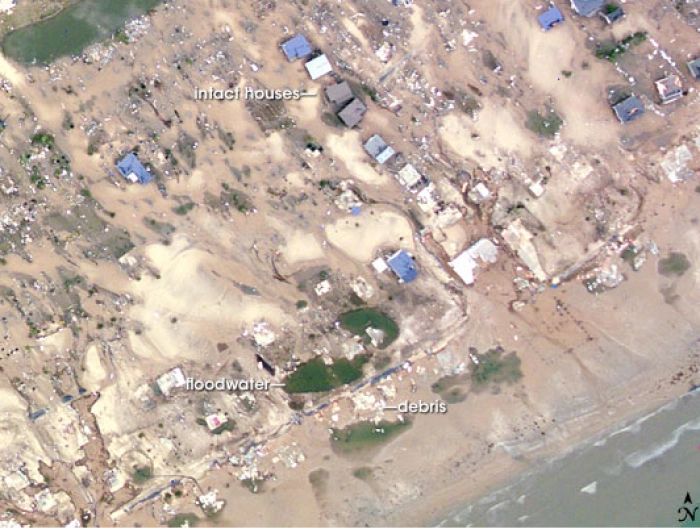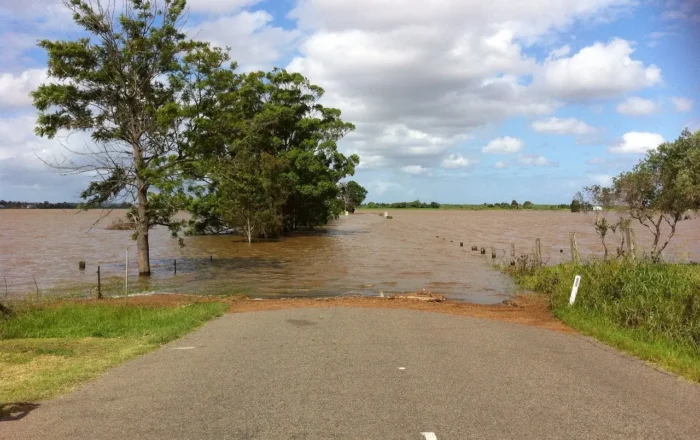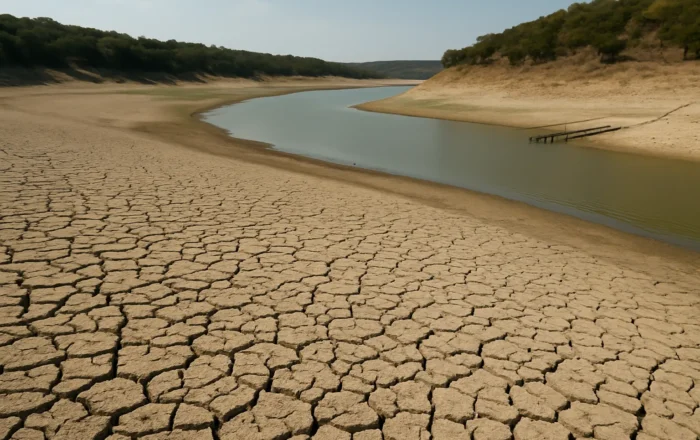What Causes Floods in Texas?
4 minute readFlooding in Texas is driven by heavy rain, hurricanes, rivers, and rapid urban growth, making it one of the most flood-prone states in the nation.
Home > BKV Energy Blog > All Posts > Texas Hurricane History: The Largest Storms to Hit Texas
Uncover Texas's hurricane history and how they transformed preparedness in the Lone Star State.
3 minute read • Last update July 2025

Since 1851, there have been 10 recorded category 4 hurricanes to make landfall in Texas. Some of the more well-known storm names include Hurricane Harvey in 2017 and the 1900 Galveston Hurricane. Hurricane Harvey moved slowly over the Houston area, dropping nearly 50 inches of rain that flooded the city. The storm is estimated to have inflicted $125 billion worth of damage, completely destroying over 60,000 homes and damaging over 200,000 others.
Many Texans remember Hurricane Ike in 2008, which at one point was a category 4, but had decreased in intensity to category 2 by the time it collided with Texas in the Galveston area. Even with the lower category rating, Ike was one of the most destructive hurricanes to hit the state. Some parts of the state were expected to receive a storm surge up to 20 feet.
Texas has never had a storm hit the state while meeting the criteria of a category 5 hurricane.
On the table below you can see a list of major hurricanes to hit Texas since the year 1900.
| Name | Category | Year | Location |
|---|---|---|---|
| 1900 Galveston Hurricane | 4 | 1900 | Galveston |
| Velasco | 3 | 1909 | Velasco |
| Galveston | 4 | 1915 | Galveston |
| 1916 Texas Hurricane | 4 | 1916 | Corpus Christi |
| Florida Keys Hurricane | 3 | 1919 | Corpus Christi |
| Freeport | 4 | 1932 | Freeport |
| 1941 Texas Hurricane | 3 | 1941 | Bay City |
| 1942 Matagorda Hurricane | 3 | 1942 | Matagorda |
| 1945 Texas Hurricane | 3 | 1945 | Port O’Connor |
| Audrey | 3 | 1957 | Sabine Pass |
| Carla | 4 | 1961 | Port Lavaca |
| Beulah | 3 | 1967 | Rio Grande Valley |
| Celia | 4 | 1970 | Port Aransas |
| Allen | 3 | 1980 | Brownsville |
| Alicia | 3 | 1983 | Galveston |
| Bret | 3 | 1999 | Padre Island |
| Rita | 3 | 2005 | Texas – Louisiana border |
| Harvey | 4 | 2017 | Houston |
Since the 1850s, Texas has been struck by over 60 hurricanes. Most hurricanes that make landfall in Texas are category 1 and 2, but since the 1850s, the state has dealt with over 25 major (category 3 and up) hurricanes.
| Hurricane/Tropical Storm | Category | Year |
|---|---|---|
| 1900 Galveston Hurricane | 4 | 1900 |
| Hurricane Carla | 4 | 1961 |
| Hurricane Alicia | 3 | 1983 |
| Tropical Storm Allison | TS | 2001 |
| Hurricane Rita | 3 | 2005 |
| Hurricane Ike | 2 | 2008 |
| Hurricane Harvey | 4 | 2017 |
| Hurricane Beryl | 1 | 2024 |
| Hurricane/Tropical Storm | Category | Year |
|---|---|---|
| 1900 Galveston Hurricane | 4 | 1900 |
| 1915 Galveston Hurricane | 4 | 1915 |
| Hurricane Carla | 4 | 1961 |
| Hurricane Alicia | 3 | 1983 |
| Hurricane Ike | 2 | 2008 |
The 1900 Galveston hurricane remains the deadliest natural disaster in U.S. history, with an estimated death toll between 6,000 and 12,000 people, most commonly cited as approximately 8,000 fatalities. Striking on September 8, 1900, this Category 4 storm brought sustained winds exceeding 130 mph and a storm surge of 15 feet, inundating the low-lying island city of Galveston, Texas. At the time, Galveston was a thriving port city with a population of around 40,000. The hurricane destroyed about 3,600 buildings, leaving approximately 10,000 residents homeless and causing extensive property damage estimated at $28–30 million in 1900 dollars. The catastrophe effectively ended Galveston’s prominence as a commercial hub, shifting economic growth to nearby Houston. In the aftermath, significant engineering efforts were undertaken, including the construction of a 17-foot-high seawall and the elevation of the island’s grade, to mitigate future storm impacts.
The 2025 Atlantic hurricane season is projected to exhibit above-average activity, with forecasts indicating 13 to 19 named storms, 6 to 10 hurricanes, and 3 to 5 major hurricanes (Category 3 or higher).
While it’s impossible to predict with certainty whether Texas will experience a direct hurricane landfall, the state’s Gulf Coast remains vulnerable due to prevailing atmospheric and oceanic conditions. Storms originating in the Atlantic can follow diverse trajectories, potentially impacting regions such as the East Coast, Florida, Louisiana, or Mexico.
Key factors contributing to the heightened activity include warmer-than-average sea surface temperatures in the Atlantic, ENSO-neutral conditions, and increased precipitation in the Sahel region of Africa. These elements are all conducive to tropical cyclone development.
Given these conditions, stakeholders in Texas and along the Gulf Coast should prioritize preparedness and resilience planning for the upcoming hurricane season. In the case that a storm does head for Texas, you can prepare by familiarizing yourself with the difference between a hurricane watch and warning, as well as our Hurricane Safety & Preparedness Guide.
When choosing an electricity provider in Texas, it’s important to select a company that has experience dealing with hurricanes. BKV Energy’s team has firsthand experience managing hurricane impacts and is prepared to offer support before, during, and after major disasters. Our stellar call center and customer support team that is prepared to offer support before, during, and after major disasters.
Explore rates in your neighborhood by entering your zip code. BKV Energy’s Bluebonnet plan is simple, affordable, and packed with benefits.
Graham Lumley, Digital Marketing Manager at BKV Energy, leads digital and traditional marketing strategies, focusing on educating Texans about the state's deregulated energy market. With over 8 years of marketing experience, he creates content to help consumers understand and save on their energy bills, bringing a fresh and dynamic approach to the industry.

Flooding in Texas is driven by heavy rain, hurricanes, rivers, and rapid urban growth, making it one of the most flood-prone states in the nation.

Texas has faced decades of drought cycles, but is the state still in a drought today?
Get $50 off your electric bill!
Use code BKVEJOINUS50
Enter your zip code to shop BKV Energy's affordable, fixed-rate Texas electricity plans. Use the promo code for $50 off your electric bill.